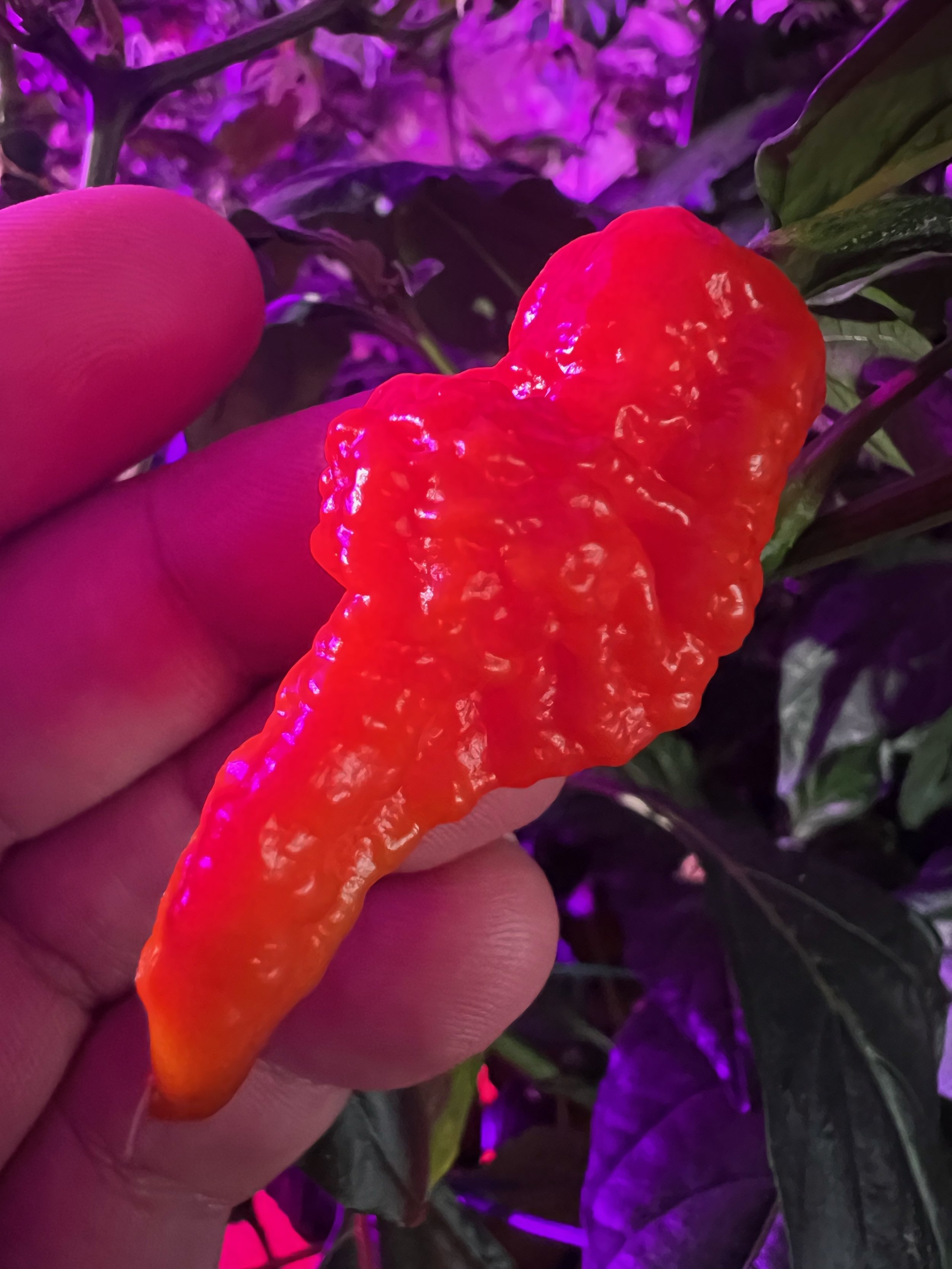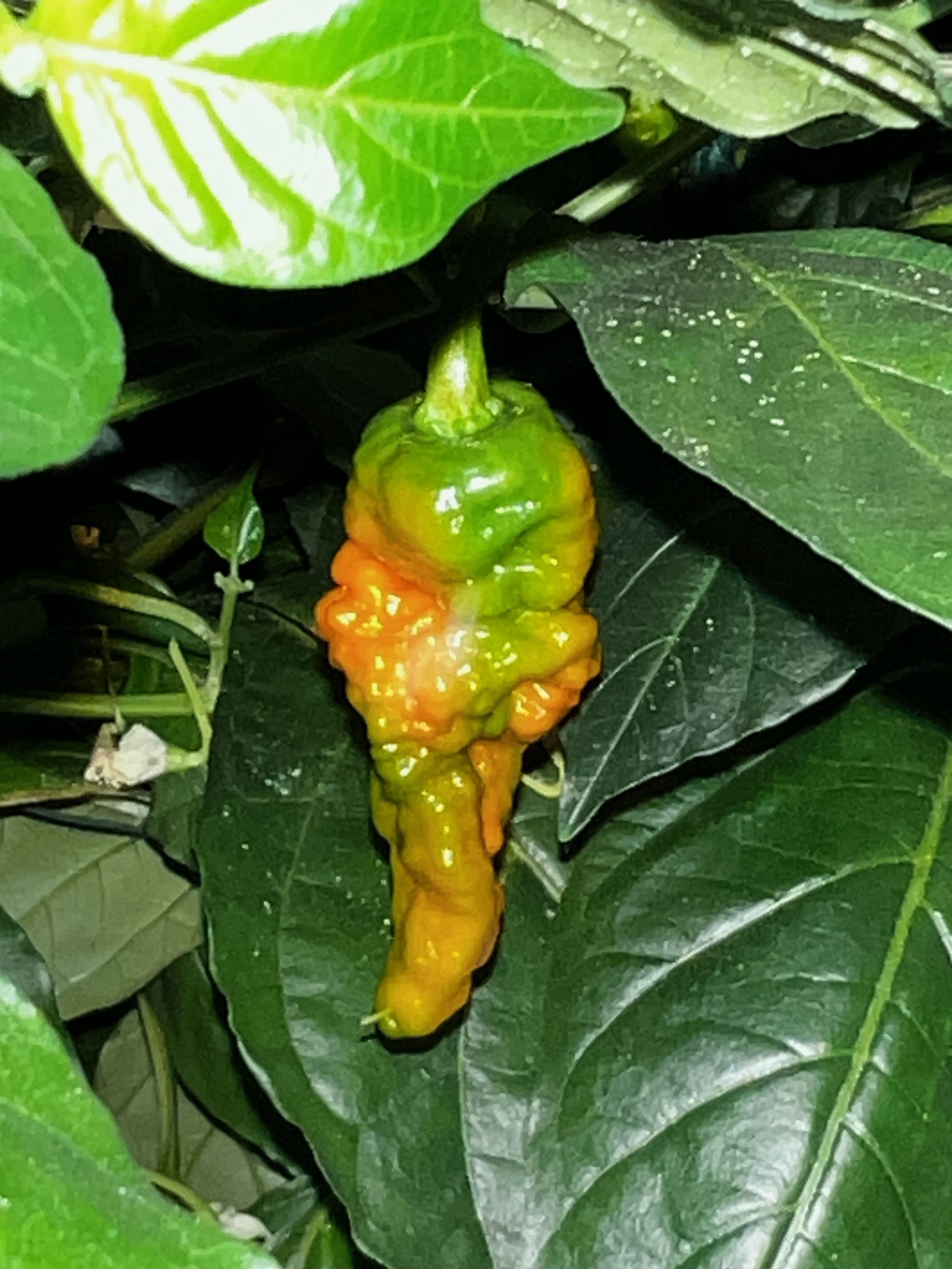Habanero Pepper Seeds
Habanero peppers are a type of chili pepper known for their intense heat and fruity flavor. Here are some key characteristics and information about habanero peppers:
Heat Level: Habanero peppers are among the hottest chili peppers in the world. They typically have a Scoville Heat Unit (SHU) rating ranging from 100,000 to 350,000, although some varieties can be even hotter. To put this in perspective, they are significantly hotter than jalapeño peppers, which typically range from 2,500 to 8,000 SHU.
Appearance: Habanero peppers are small, typically measuring about 1 to 2.5 inches (2.5 to 6.4 centimeters) in length. They have a lantern-like shape with a wrinkled skin and come in various colors, including bright orange, red, yellow, and green. The color varies depending on the ripeness of the pepper.
Flavor: Despite their intense heat, habanero peppers are known for their unique and complex flavor. They have a fruity, citrusy, and slightly floral taste that adds a distinctive element to dishes. This flavor makes habaneros a popular choice for adding both heat and flavor to recipes.
Culinary Uses: Habanero peppers are used in various cuisines around the world, particularly in Latin American and Caribbean dishes. They can be used fresh or dried and are often added to salsas, hot sauces, marinades, and spicy dishes. Be cautious when handling habanero peppers, as their oils can irritate the skin and eyes, so it's advisable to wear gloves when working with them.
Health Benefits: Like other chili peppers, habaneros contain capsaicin, a compound responsible for their heat. Capsaicin has been linked to several potential health benefits, including pain relief, increased metabolism, and potential anti-inflammatory properties. However, consuming habaneros in excess can lead to digestive discomfort and discomfort for individuals not accustomed to spicy foods.
Growing Habanero Peppers: Habanero peppers can be grown in many regions, but they thrive in warm and sunny climates. They are typically grown as annual plants and require well-draining soil and regular watering. They can be started from seeds indoors and then transplanted into the garden or grown directly from seed in warmer climates.
Varieties: There are numerous varieties of habanero peppers, each with its own unique flavor and heat level. Some well-known habanero varieties include the Orange Habanero, Red Savina, Chocolate Habanero, and Scotch Bonnet, which is often considered a close relative of the habanero.
Habanero peppers are beloved by spice enthusiasts for their fiery heat and distinctive flavor, and they continue to be a popular choice for adding heat to a wide range of culinary dishes and hot sauces. However, due to their intense heat, it's important to use habanero peppers sparingly if you're not accustomed to very spicy foods.
Habanero peppers are a type of chili pepper known for their intense heat and fruity flavor. Here are some key characteristics and information about habanero peppers:
Heat Level: Habanero peppers are among the hottest chili peppers in the world. They typically have a Scoville Heat Unit (SHU) rating ranging from 100,000 to 350,000, although some varieties can be even hotter. To put this in perspective, they are significantly hotter than jalapeño peppers, which typically range from 2,500 to 8,000 SHU.
Appearance: Habanero peppers are small, typically measuring about 1 to 2.5 inches (2.5 to 6.4 centimeters) in length. They have a lantern-like shape with a wrinkled skin and come in various colors, including bright orange, red, yellow, and green. The color varies depending on the ripeness of the pepper.
Flavor: Despite their intense heat, habanero peppers are known for their unique and complex flavor. They have a fruity, citrusy, and slightly floral taste that adds a distinctive element to dishes. This flavor makes habaneros a popular choice for adding both heat and flavor to recipes.
Culinary Uses: Habanero peppers are used in various cuisines around the world, particularly in Latin American and Caribbean dishes. They can be used fresh or dried and are often added to salsas, hot sauces, marinades, and spicy dishes. Be cautious when handling habanero peppers, as their oils can irritate the skin and eyes, so it's advisable to wear gloves when working with them.
Health Benefits: Like other chili peppers, habaneros contain capsaicin, a compound responsible for their heat. Capsaicin has been linked to several potential health benefits, including pain relief, increased metabolism, and potential anti-inflammatory properties. However, consuming habaneros in excess can lead to digestive discomfort and discomfort for individuals not accustomed to spicy foods.
Growing Habanero Peppers: Habanero peppers can be grown in many regions, but they thrive in warm and sunny climates. They are typically grown as annual plants and require well-draining soil and regular watering. They can be started from seeds indoors and then transplanted into the garden or grown directly from seed in warmer climates.
Varieties: There are numerous varieties of habanero peppers, each with its own unique flavor and heat level. Some well-known habanero varieties include the Orange Habanero, Red Savina, Chocolate Habanero, and Scotch Bonnet, which is often considered a close relative of the habanero.
Habanero peppers are beloved by spice enthusiasts for their fiery heat and distinctive flavor, and they continue to be a popular choice for adding heat to a wide range of culinary dishes and hot sauces. However, due to their intense heat, it's important to use habanero peppers sparingly if you're not accustomed to very spicy foods.
Habanero peppers are a type of chili pepper known for their intense heat and fruity flavor. Here are some key characteristics and information about habanero peppers:
Heat Level: Habanero peppers are among the hottest chili peppers in the world. They typically have a Scoville Heat Unit (SHU) rating ranging from 100,000 to 350,000, although some varieties can be even hotter. To put this in perspective, they are significantly hotter than jalapeño peppers, which typically range from 2,500 to 8,000 SHU.
Appearance: Habanero peppers are small, typically measuring about 1 to 2.5 inches (2.5 to 6.4 centimeters) in length. They have a lantern-like shape with a wrinkled skin and come in various colors, including bright orange, red, yellow, and green. The color varies depending on the ripeness of the pepper.
Flavor: Despite their intense heat, habanero peppers are known for their unique and complex flavor. They have a fruity, citrusy, and slightly floral taste that adds a distinctive element to dishes. This flavor makes habaneros a popular choice for adding both heat and flavor to recipes.
Culinary Uses: Habanero peppers are used in various cuisines around the world, particularly in Latin American and Caribbean dishes. They can be used fresh or dried and are often added to salsas, hot sauces, marinades, and spicy dishes. Be cautious when handling habanero peppers, as their oils can irritate the skin and eyes, so it's advisable to wear gloves when working with them.
Health Benefits: Like other chili peppers, habaneros contain capsaicin, a compound responsible for their heat. Capsaicin has been linked to several potential health benefits, including pain relief, increased metabolism, and potential anti-inflammatory properties. However, consuming habaneros in excess can lead to digestive discomfort and discomfort for individuals not accustomed to spicy foods.
Growing Habanero Peppers: Habanero peppers can be grown in many regions, but they thrive in warm and sunny climates. They are typically grown as annual plants and require well-draining soil and regular watering. They can be started from seeds indoors and then transplanted into the garden or grown directly from seed in warmer climates.
Varieties: There are numerous varieties of habanero peppers, each with its own unique flavor and heat level. Some well-known habanero varieties include the Orange Habanero, Red Savina, Chocolate Habanero, and Scotch Bonnet, which is often considered a close relative of the habanero.
Habanero peppers are beloved by spice enthusiasts for their fiery heat and distinctive flavor, and they continue to be a popular choice for adding heat to a wide range of culinary dishes and hot sauces. However, due to their intense heat, it's important to use habanero peppers sparingly if you're not accustomed to very spicy foods.
Disclaimer for Non-Isolated Pepper Seeds
Thank you for choosing to purchase our pepper seeds. We want to ensure that you are well-informed about the nature of the seeds you are acquiring. Please take a moment to read and understand the following disclaimer:
1. Cross-Pollination Possibility: The pepper seeds you are purchasing have not been isolated from other pepper varieties. This means that there is a possibility of cross-pollination occurring in your garden or growing environment. Cross-pollination can result in plants that exhibit characteristics of both parent plants, potentially leading to unexpected variations in the peppers grown from these seeds.
2. Genetic Variability: Cross-pollination may introduce genetic variability, resulting in peppers that differ in flavor, size, color, or other characteristics from the parent pepper plants. While this can be an exciting aspect of growing peppers, it is essential to be aware that the outcome may not always match the characteristics of the original pepper variety.
3. No Guarantee of Purity: Due to the potential for cross-pollination, we cannot guarantee the purity of the pepper seeds you purchase. They may not produce peppers that are identical to the parent plant or the variety description.
4. Best Practices: To minimize the risk of cross-pollination, we recommend following best practices for growing and isolating pepper plants. This may include physical separation, distance, or timing of planting to avoid cross-pollination with other pepper varieties.
5. No Refunds or Returns: As cross-pollination is a natural process and beyond our control, we regret that we cannot offer refunds or accept returns based on the characteristics of peppers grown from these seeds.
By purchasing these pepper seeds, you acknowledge and accept the potential for cross-pollination and the variability it may introduce. We encourage you to embrace the adventure of growing unique peppers and experimenting with new flavors and traits.
If you have any questions or concerns about our pepper seeds or need guidance on growing practices, please feel free to contact us. We are here to assist you in any way we can.
Thank you for choosing our pepper seeds and for your understanding of the inherent variability in non-isolated seed varieties.
Sincerely,
Cary Meltzer - Owner/CEO Hydro Peppers LLC
















